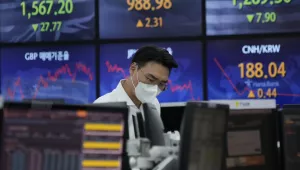Emerging markets have performed amazingly well over the last seven years. They have outperformed the advanced industrialized countries in terms of economic growth, debt-to-GDP ratios, and countercyclical fiscal policy. Many now receive better assessments by rating agencies and financial markets than some of the advanced economies.
As 2012 begins, however, emerging markets may be due for a correction, triggered by a new wave of “risk off” behavior among investors. Will China experience a hard landing? Will a decline in commodity prices hit Latin America? Will the sovereign-debt woes of the European periphery spread to neighbors such as Turkey in a new “Aegean crisis”?
Engorged by large capital inflows, some emerging market countries were in an overheated state a year ago. It is unlikely that the rapid economic growth and high trade deficits that Turkey has experienced in recent years can be sustained. Likewise, high GDP growth rates in Brazil and Argentina over the same period could soon reverse, particularly if global commodity prices fall - not a remote prospect if the Chinese economy falters or global real interest rates were to rise this year. China, for its part, could land hard as its real-estate bubble deflates and the country’s banks are forced to work off their bad loans.
The World Bank has now downgraded economic forecasts for developing countries in 2012 (Global Economic Prospects, Jan.18, 2012). Brazil’s economic growth, for example, came to a halt in the third quarter of 2011 and is forecast at only 3.4 percent in 2012 …well below the rapid 2010 growth rate of 7.5 percent. Reflecting a sharp slowdown in the second half of the year in India, South Asia is coming off of a torrid six years, including 9.1 percent growth in 2010. Regional growth is projected to ease further to 5.8 percent in 2012.
But will economic slowdown turn to financial crash? Three possible lines of argument support the worry that emerging markets’ performance are fated to suffer dramatically in 2012: empirical, literary, and causal. Each line of argument is admittedly tentative.
The empirical argument is just historically based numerology: emerging-market crises seem to come in 15-year cycles. The international debt crisis surfaced in Mexico in mid-1982, and then spread to the rest of Latin America and beyond. The East Asian crisis erupted 15 years later, in Thailand in mid-1997, and then spread to the rest of the region and beyond. We are now another 15 years down the road. So is 2012 the time for the third round of emerging markets crises?
The hypothesis of regular boom-bust cycles is supported by a long-standing scholarly literature, such as the writings of Carmen Reinhart. But I would appeal to an even older source: the Old Testament - in particular, the story of Joseph, who was called upon by the Pharaoh to interpret a dream about seven fat cows followed by seven skinny cows.
Joseph prophesied that there would come seven years of plenty, with abundant harvests from an overflowing Nile, followed by seven lean years, with famine resulting from drought. His forecast turned out to be accurate. Fortunately the Pharaoh had empowered his technocratic official (Joseph) to save grain in the seven years of plenty, building up sufficient stockpiles to save the Egyptian people from starvation during the bad years. That is a valuable lesson for today’s government officials in industrialized and developing countries alike.
For emerging markets, the first phase of seven years of plentiful capital flows occurred in 1975-1981, with the recycling of petrodollars in the form of loans to developing countries. The international debt crisis that began in Mexico in 1982 was the catalyst for the seven lean years, known in Latin America as the “lost decade.” The turnaround year, 1989, was marked by the first issue of Brady bonds, which helped write down the debt overhang and put a line under the crisis.
The second cycle of seven fat years was the period of record capital flows to emerging markets in 1990-1996. Following the 1997 “sudden stop” in East Asia came seven years of capital drought. The third cycle of inflows, often identified as a “carry trade,” came in 2004-2011 and persisted even through the global financial crisis. If history repeats itself, it is now time for a third sudden stop of capital flows to emerging markets.
Are a couple of data points and a biblical parable enough to take the hypothesis of a 15-year cycle seriously? We need some sort of causal theory that could explain such periodicity to international capital flows.
Here is a possibility: 15 years is how long it takes for individual loan officers and hedge-fund traders to be promoted out of their jobs. Today’s young crop of asset pickers knows that there was a crisis in Turkey in 2001, but they did not experience it first hand. They think that perhaps this time is different.
If emerging markets crash in 2012, remember where you heard it first - in ancient Egypt.
[This article was published in Project Syndicate, which holds the copyright.]
.
Frankel, Jeffrey. “Will Emerging Markets Fall In 2012.” January 23, 2012



